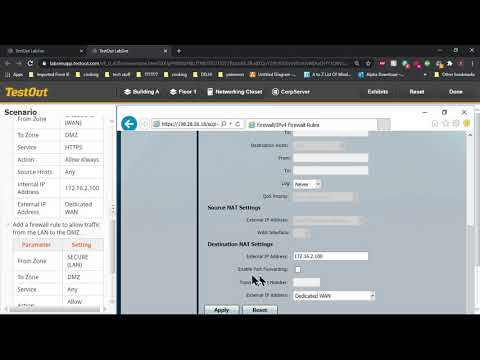
- #Testout lab 6.7.4 configure a perimeter firewall how to#
- #Testout lab 6.7.4 configure a perimeter firewall windows 10#
All three require an XML VPN profile to configure the appropriate VPN settings.Deny login from the WAN interface Hide Details
#Testout lab 6.7.4 configure a perimeter firewall windows 10#
You can use several technologies to configure Windows 10 VPN clients, including Windows PowerShell, Microsoft Endpoint Configuration Manager, and Intune. Configure Windows 10 Client Always On VPN Connections: In this step, you configure the Windows 10 client computers to communicate with that infrastructure with a VPN connection. For more information, see Configure Firewalls for RADIUS Traffic. If you are not using the default RADIUS ports in your NPS deployment, you must configure the firewall to allow RADIUS traffic on the ports that you are using. If you use the default RADIUS port configuration on the VPN Server and the NPS Server, make sure that you open the following ports on the Internal Perimeter Network Firewall:

Use the Same RADIUS Ports for the Internal Perimeter Network Firewall Configuration If your network access servers are configured to send RADIUS traffic over ports other than these defaults, remove the exceptions created in Windows Firewall with Advanced Security during NPS installation, and create exceptions for the ports that you do use for RADIUS traffic. The VPN server sends RADIUS traffic to the NPS on the corporate network and also receives RADIUS traffic from the NPS.Ĭonfigure the firewall to allow RADIUS traffic to flow in both directions. In this deployment, the Remote Access VPN server on the perimeter network is configured as a RADIUS client. For a visual representation of this separation, see the illustration in the topic Always On VPN Technology Overview. The Internal Perimeter Network Firewall separates the Organization/Corporate Network from the Internal Perimeter Network. Configure the Internal Perimeter Network Firewall
#Testout lab 6.7.4 configure a perimeter firewall how to#
In either case, if your firewall supports deep packet inspection and you have difficulty establishing client connections, you should attempt to relax or disable deep packet inspection for IKE sessions.įor information on how to make these configuration changes, see your firewall documentation. If you're routing traffic inbound and performing NAT at or behind the VPN server, then you must open your firewall rules to allow UDP ports 5 inbound to the external IP address applied to the public interface on the VPN server. Forward these ports to the IP address that is assigned to the external interface of your VPN server. If you use Network Address Translation (NAT) on your edge firewall, you might need to enable port forwarding for User Datagram Protocol (UDP) ports 5. Your Edge Firewall must allow and forward specific ports to your VPN server. The Edge Firewall separates the External Perimeter Network from the Public Internet. Selecting this option creates an additional pointer (PTR) resource record in a reverse zone for this host, based on the information you entered in Name and IP address.

In IP address, enter the IP address for the VPN server.In New Host, in Name, enter the certificate subject alternative name for the VPN server.In Forward Lookup Zones details, right-click the forward lookup zone to which you want to add a record, and then select New Host (A or AAAA).In the details pane, in Name, double-click Forward Lookup Zones to expand the view.In the DNS Manager console tree, select the server that you want to manage.On a DNS server, in Server Manager, select Tools, and then select DNS.To add a host (A or AAAA) resource record to a zone

The A record should use the certificate subject alternative name for the VPN server. To ensure that remote clients can connect to your VPN server, you can create a DNS A (Host) record in your external DNS zone.

When remote VPN clients connect, they use the same DNS servers that your internal clients use, which allows them to resolve names in the same manner as the rest of your internal workstations.īecause of this, you must ensure that the computer name that external clients use to connect to the VPN server matches the subject alternative name defined in certificates issued to the VPN server. In this step, you configure DNS and Firewall settings for VPN connectivity. Configure Windows 10 Client Always On VPN Connections Applies to: Windows Server 2022, Windows Server 2019, Windows Server 2016, Windows Server 2012 R2, Windows 10


 0 kommentar(er)
0 kommentar(er)
